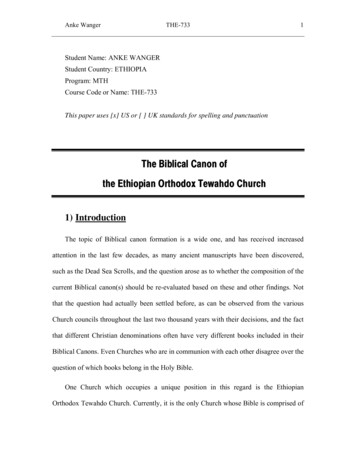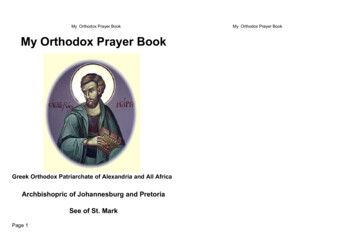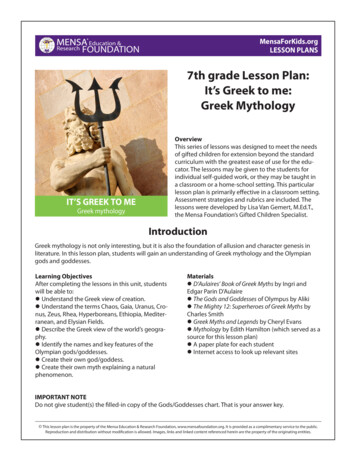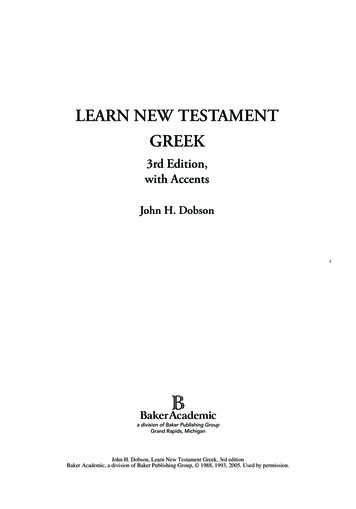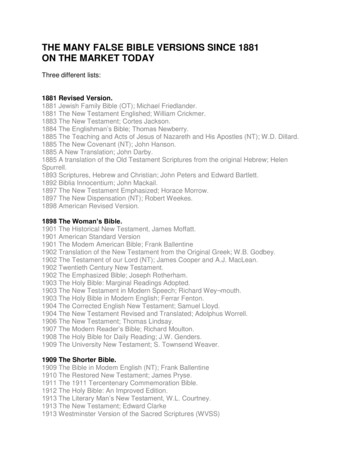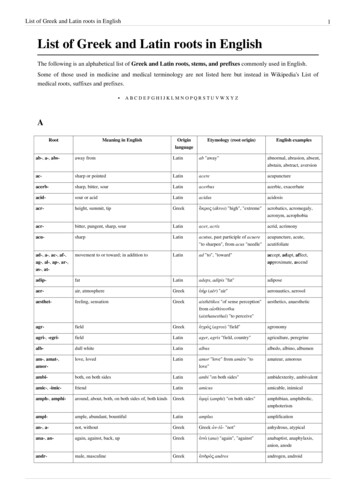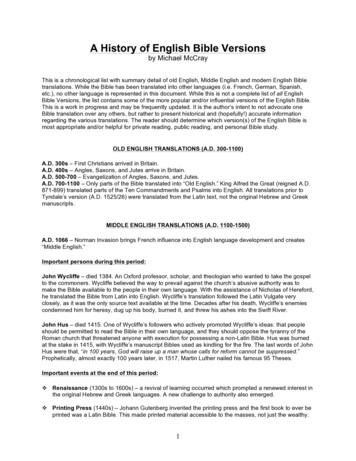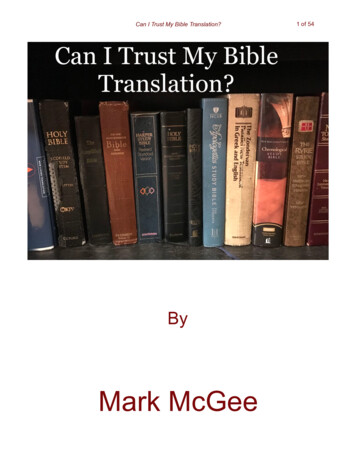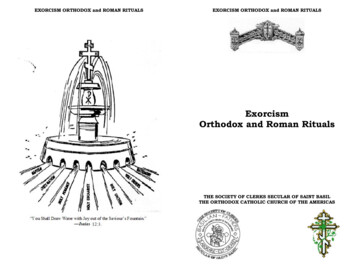
Transcription
THE EASTERN - GREEKORTHODOX BIBLE :NEW TESTAMENTPresented toPresented byDate – Occasion
THE EASTERN - GREEKORTHODOX BIBLENEWTESTAMENT
THE EASTERN / GREEKORTHODOX BIBLEBASED ON THE SEPTUAGINTAND THE PATRIARCHAL TEXTNEW TESTAMENTALSO KNOWN ASTHE CHRISTIAN GREEKSCRIPTURESWith extensive introductory and supplemental material
The EOB New Testament is presented in memory ofArchbishop Vsevolod of Scopelos (†2007)Ukrainian Orthodox Church of the USAEcumenical Patriarchate of ConstantinopleAnd in honor ofHis Beatitude Metropolitan JonahPrimate of the Orthodox Church in America
ABBREVIATIONS AND CODES[]Indicates words added for clarity and accuracy but which may notbe in the Greek text. For public reading, these words can beincluded or skipped{}Indicates words added for theological clarity and accuracy. Forpublic reading, these words should be skipped Indicates words that may have been added in the Byzantine textualtradition for the purpose of clarification, harmonization or liturgicaluse and which are present in the PT, but which may not have beenpart of the original manuscriptsANF/PNFAnte-Nicene Fathers / Post-Nicene FathersBACBeing as Communion, John ZizioulasCCCCatechism of the Catholic ChurchCTModern “eclectic” texts or reconstructed "critical texts" (UnitedBible Societies Text (UBS) or the Nestle-Aland Text (NA))CTCCalled to Communion, Joseph RatzingerEBCEucharist, Bishop, Church, John ZizioulasEOBEastern / Greek Orthodox BibleHBBHis Broken Body, Laurent CleenewerckHEEcclesiastical History (Eusebius) (Paul Maier’s edition)KJVKing James Version (sometimes called Authorized Version)LXXGreek translation of the Old Testament known as the Septuagintwhich is the basis for the main English text of the EOB/OT
TABLE OF CONTENTSINTRODUCTORY SECTIONABBREVIATIONS AND CODES . 9TABLE OF CONTENTS. 11THE GREEK ALPHABET . 13MANUSCRIPT CODES . 14ABOUT THE EOB NEW TESTAMENT . 15THE GOSPELSINTRODUCTION TO THE SYNOPTIC GOSPELS AND ACTS . 35(ACCORDING TO) MATTHEW (ΚΑΤΑ ΜΑΤΘΑΙΟΝ) . 41(ACCORDING TO) MARK (ΚΑΤΑ ΜΑΡΚΟΝ) . 107(ACCORDING TO) LUKE (ΚΑΤΑ ΛΟΥΚΑΝ) . 149INTRODUCTION TO THE GOSPEL OF JOHN . 219(ACCORDING TO) JOHN (ΚΑΤΑ ΙΩΑΝΝΗΝ) . 229ACTS, EPISTLES AND REVELATIONACTS OF THE APOSTLES (ΠΡΑΞΕΙΣ ΤΩΝ ΑΠΟΣΤΟΛΩΝ) . 281INTRODUCTION TO THE PAULINE EPISTLES . 341ROMANS (ΠΡΟΣ ΡΩΜΑΙΟΥΣ) . 3491 CORINTHIANS (ΠΡΟΣ ΚΟΡΙΝΘΙΟΥΣ Α). 3742 CORINTHIANS (ΠΡΟΣ ΚΟΡΙΝΘΙΟΥΣ Β) . 396GALATIANS (ΠΡΟΣ ΓΑΛΑΤΑΣ) . 410EPHESIANS (ΠΡΟΣ ΕΦΕΣΙΟΥΣ) . 418PHILIPPIANS (ΠΡΟΣ ΦΙΛΙΠΠΗΣΙΟΥΣ) . 426COLOSSIANS (ΠΡΟΣ ΚΟΛOΣΣΑΕΙΣ). 4321 THESSALONIANS (ΠΡΟΣ ΘΕΣΣΑΛΟΝΙΚΕΙΣ Α) . 438
INTRODUCTIONTHE GREEK ALPHABETLetter NameLower CaseUpper CaseTransliterationAlpha aBeta bGamma gDelta dEpsilon eZeta zÊta e (ê or ē)Thêta thIota iKappa kLambda lMu mNu nXi ksOmicron oPi pRho rSigma sTau tUpsilon u (sometimes v or y)Phi phChi chPsi psOmega ô or ō
INTRODUCTIONABOUT THE EOB NEW TESTAMENTPURPOSEThe EOB New Testament was prepared for personal study and liturgicaluse in English-speaking Orthodox Christian communities. Its format andfont are designed to make both activities accessible and rewarding. Everyattempt has been made to offer an accurate and scholarly translation of theGreek text, free of the theological bias that has affected most othertranslations of the New Testament, including the NIV (2 Thess. 2:15) andNAB (Matt. 5:32).Another intention of this translation is to foster interest in learning theGreek language (biblical, patristic and modern), which is why manyfootnotes make reference to the underlying Greek vocabulary.The purpose of this edition is also to make the reader aware of possibletextual variants by footnoting all significant instances where thePatriarchal Text (PT) may not agree with the Textus Receptus (TR), theMajority Text (MT) or the Critical Text (CT). In several instances, thefootnotes will provide references to specific manuscripts.Until the publication of the EOB, the King James and New King Jamesversions have been the preferred translations, partly because they are basedon the Textus Receptus (TR) which is a Byzantine-type text that is closeto the normative ecclesiastical text of the Greek-speaking OrthodoxChurches.The Textus Receptus (Latin: “received text”) is the namesubsequently given to the succession of printed Greek texts of theNew Testament which constituted the translation base for Luther’soriginal German Bible. The TR was also used for the translation ofthe New Testament into English by William Tyndale, for the KingJames Version, and for most other Reformation-era NewTestament translations throughout Western and Central Europe.
INTRODUCTIONcertain issues of translation and terminology (discussed below) also calledfor revisions within an Orthodox context.The EOB (Eastern/Greek Orthodox Bible or Holy Bible of the[Eastern/Greek] Orthodox Churches) addresses these limitations, bothin the Old and New Testaments. A limited copyright (see inner front page)is held by the publisher but the text is non-commercial, held within theOrthodox community and managed as a collaborative project, both forrevisions and for liturgical use. Moreover, Orthodox Christians are invitedto submit their suggestions so that the published text may be regularlyupdated and improved.EOB FOOTNOTESUnlike the Orthodox Study Bible (OSB), the EOB footnotes focus ontextual and translation issues, and refrain from providing extensivetheological or doctrinal interpretations. Hence, the goal of the main text isto provide the reader with a clear sense of what the Scriptures say withpossible nuances, not how they should be interpreted.There are two reasons for this philosophy. The first one is that footnotecommentaries are often perceived as “authoritative” by the reader – almoston the level of Scripture or official commentary. Hence, the reader’s attentionis directed to particular explanation, at the risk of not letting the inspiredtext speak for itself. The second reason is that a few of the explanatoryfootnotes of the OSB may be debated among Orthodox theologians, as in thecase of Acts 1:20 and Revelation 17:1 among others. Please refer to theintroductions and appendices for appropriate explanations.PRIMARY GREEK TEXT(S)The translation of the New Testament included in the EOB is based on theofficial Greek text published by the Ecumenical Patriarchate ofConstantinople in 1904 (Patriarchal Text or PT). During the Turkishoccupation of the Greek lands, various editions of the NT had beenpublished with significant variants. In 1902, in order to ensureecclesiastical harmony, the Ecumenical Patriarchate appointed a committeewhose task was to publish a common and official text. This committeestudied about 20 major Byzantine manuscripts from which they adoptedone as starting point, yet taking into consideration significant variantsfrom other manuscripts. This text, which is very close to the so-calledMajority Text (MT), was published for the first time in 1904. It has sincethen been adopted by all Greek-speaking Orthodox Churches(Constantinople, Alexandria, Jerusalem, Greece, Cyprus, and Crete). Itspurpose is not to offer an always speculative reconstruction of the original
INTRODUCTIONsignificant variants between PT/MT/TR and CT have been studied andfootnoted to provide variant readings.The Byzantine text-type (also called Majority, Traditional,Ecclesiastical, Constantinopolitan, or Syrian) is one of severaltext-types used in textual criticism to describe the textualcharacter of certain Greek New Testament manuscripts. It is theform found in the largest number of surviving manuscripts.The New Testament text of the Greek Orthodox Churches, thePatriarchal edition of 1904 (PT), is based on this text-type. Thistextual tradition also underlies the Textus Receptus Greek text.A synthetic Greek New Testament text based on these majorityreadings – hence the name “Majority Text” – has been producedby Zane C. Hodges and Arthur L. Farstad, although this text doesnot correspond to any one particular manuscript.There are only six manuscripts earlier than the 9th century whichconform to the Byzantine text-type; of which the 5th centuryCodex Alexandrinus, (the oldest), is Byzantine only in the Gospelswith the rest of the New Testament being Alexandrian. Bycomparison, the Alexandrian text-type is witnessed by ninesurviving uncials earlier than the ninth century (including theCodex Alexandrinus outside the Gospels); and is also usuallyconsidered to be demonstrated in three earlier papyri. Moderncritical editions of the New Testament tend to conform most oftento Alexandrian witnesses – especially Codex Sinaiticus and CodexVaticanus (see below). The earliest of the Church Fathers who isconsidered to be a consistent witness to a Byzantine text-type inNT quotations is St. John Chrysostom.Orthodox Christians should be aware that the foundational Greek textused by most modern translations such as the New International Versionand (New) Revised Standard Version is the Critical Text (CT). Bycontrast, the foundational text for the King James and New King Jamesversions is the Textus Receptus (TR). Moreover, many use the dynamicequivalency translation approach as opposed to formal-equivalency. Dueto doctrinal bias and other aberrations, these translations are generallyprohibited for ecclesiastical use by Orthodox hierarchs.
INTRODUCTIONnoticed by the monks, but in spite of the growing concern of his hosts, theGerman visitor was still able to consult ancient texts of great value. Whenhe returned to the Monastery several years later to present as a gift hisrecently published edition of the Septuagint, his monastic guests expressedinterest and appreciation. Tischendorf writes:On the afternoon of this day, I was taking a walk with the steward of theconvent in the neighborhood, and as we returned, towards sunset, hebegged me to take some refreshment with him in his cell. Scarcely had heentered the room, when, resuming our former subject of conversation, hesaid: “And I, too, have read a Septuagint,” i.e. a copy of the Greektranslation made by the Seventy. And so saying, he took down from thecorner of the room a bulky kind of volume, wrapped up in a red cloth, andlaid it before me. I unrolled the cover, and discovered, to my great surprise,not only those very fragments which, fifteen years before, I had taken out ofthe basket, but also other parts of the Old Testament, the New Testamentcomplete, and, in addition, the Epistle of Barnabas and a part of the Pastorof Hermas.aTsar Alexander II, who had commissioned Tischendorf’s expedition, sentthe monastery 9,000 rubles to compensate the monastery for the ‘loss’ ofthe manuscript. It should be noted that Tischendorf had promised that thecodex would be returned to the monastery, but this never happened.Instead, this ancient treasure was long kept by the Russian NationalLibrary and in 1933, the Soviet Union sold it to the British Library for 100,000.Hence, Codex Sinaiticus is not only one of the oldest manuscripts availabletoday (330-350), it is also Orthodox in origin and was not itself ‘discoveredin a trash can’ as many mistakenly believe. On the other hand, the codex isheavily corrected and may not be as reliable as modern textual critics oftenclaim.Codex Vaticanus (Vatican Library, Gregory-Aland no. B or 03) is also oneof the oldest extant manuscripts of the Bible. Its origins are not known, butit has been suggested that Codex Vaticanus was among the fifty biblescommissioned by Emperor St. Constantine I to Eusebius of Caesarea. TheEOB/OT and Brenton’s LXX are primarily based on this manuscript(except for 1-4 Maccabees and the Prayer of Manasseh which are absent).Codex Alexandrinus (British Library, Gregory-Aland no. A or 02) is a 5thcentury manuscript containing the majority of the Septuagint and the NewTestament. It is also considered as one of the earliest and most completemanuscripts of the Bible. It is named after the See of Alexandria where itaQuoted in A History of the Textual Criticism of the New Testament by Marvin Richardson Vincent, p. 16
INTRODUCTIONDuring the process of verifying, correcting and retranslating the WEB textfor the EOB/NT edition, the Patriarchal Text of 1904 and the UBS/NACritical Text were systematically consulted. In addition, recent scholarlystudies have been taken into consideration, notably Jesus as God: The NewTestament Use of Theos in Reference to Jesus (Murray J. Harris); Truth inTranslation—Accuracy and Bias in English Translations of the New Testament(Jason BeDuhn) and New Testament Text and Translation Commentary(Philip Comfort).Indeed, the revision and retranslation work has been so extensive as tomake the EOB/NT an entirely new translation prepared to ensureaccuracy and harmony with Orthodox theology and terminology.Compared to other translations, the following differences are noteworthy:CHURCH OFFICESThe Greek words dia,konoj (diakonos), presbu,teroj (presbyteros) andevpi,skopoj (episkopos), are translated respectively as “deacon” (instead of“servant” or “minister”), “presbyter” (instead of “elder”) and “overseer.”The modern English word “priest” is derived from “presbyter” but in aconfused manner: it actually conveys the idea of “one who offers a sacrifice,”which in Greek is i ereu.j (hiereus) and !hek (kohen) in Hebrew. The GreekOrthodox tradition has properly retained the distinction betweenpresbu,teroj and i ereu.j; the latter is applied to the Christian minister of thealtar in his function as offerer of the Eucharistic gifts on behalf of thepriestly people, which is why the Christian “priest” (Greek: i ereu.j Latin:sacerdos) par excellence originally was and still is the bishop. It is only withthe development of the presbyter-led parish that the term “priest” (i ereu.j)came to be applied to the presbyter in his function as celebrant of theEucharist. To this day, the annual directory of the Greek OrthodoxArchdiocese of America uses the title of “presbyter,” thereby maintainingthe most traditional and theologically accurate terminology.In the New Testament, presbyter and overseer are interchangeable andsynonymous,a which is why the EOB/NT translates evpi,skopoj (episkopos)as “overseer,” not “bishop.”For more information on the meaning of these terms and the biblicalapostolic origins of the so-called Monarchic episcopate, please refer toAppendix A.aSee Appendix A for a comprehensive discussion of this topic.
INTRODUCTIONFunction: verb; Inflected Form(s): -shipped also -shiped; -ship·ping also ship·ing1 : to honor or reverence as a divine being or supernatural power2 : to regard with great or extravagant respect, honor, or devotion synonym see REVEREAs a result, some scholars have decided to translate proskuneo consistentlyas “worship,” but many others do not use “worship” in contexts whereproskuneo is properly offered to a creature.a Indeed, there are instanceswhen proskuneo is reserved for God (Exodus 20:5 LXX, Acts 10:25, Rev.22:9) and others when proskuneo can be properly offered to creatures asderivative icons of God (1 Chronicles 29:20 LXX, 1 Kings 2:13 LXX, Rev.3:9). Hence, although ‘all honor, glory and worship are due to God,’relative honor, glory and worship are due to parents, rulers, bishops,angels, saints, etc.In the development of the Eastern Orthodox dogmatic framework and atthe time of the iconoclastic controversy, St. John of Damascus and theSeventh Ecumenical Council clarified the definition of proskuneo as“derivative or relative worship” or “veneration,” while acknowledging thefact that proskuneo can also mean “worship” in the highest sense. On thisbasis, the Council declared such acts of reverence to be proper if theintention is to ultimately honor the ‘the true God and Father’b by honoringhis icons, primarily the Son who is the perfect icon,c “True God of TrueGod” and who shares the uncreated nature of the Father,d but also createdicons, such as rulers and saints.e For clarity’s sake, the Council alsodeclared that the highest form of worship would be associated with theunambiguous word latruo/latreia, a semantic clarification and adjustmentcomparable with the one that took place with the words episkopos andousia/hypostasis.f Indeed, latreia is never used in the Scriptures in referenceto anyone but God.g As the editor of the Acts of the Seventh EcumenicalCouncil for the Post-Nicene Fathers series observed:haSome translations then use “bow down,” as NRS in Revelation 3:9John 17:3c Colossians 1:15 (evstin eivkw.n tou/ qeou/ tou/ avora,tou)d Hebrews 1:1-4e For more information on the concept of “derivation” and “relative worship” in Orthodox theology,please refer to the Appendix D article on the Filioquef See Appendix A article “Presbyters and Bishops”g In the Creed of Nicea-Constantinople, it is proskuneo, not latreia, which is used in the clause “TheSpirit, the Lord who together with the Father and the Son is worshiped and glorified ”h PNF II (Volume 14) pp. 523-528b
INTRODUCTIONgods of their fathers but to serve (abadh) the Lord (Josh. xxiv. 14). And forthe use of shachah the following may suffice: “And all the congregationblessed the Lord God of their fathers and bowed down their heads andworshiped (Hebrew, shachah; Greek, proskuneo ; Latin, adoro) the Lord andthe King” (I. Chr. xxix. 20). But while it is true of the Hebrew of the OldTestament that there is no word which refers alone to Divine Worship thisis not true of the Septuagint Greek nor of the Greek of the New Testament,for in both proskuneo has always its general meaning, sometimes applying tothe creature and sometimes to the Creator; but latreuo is used to denotedivine worship alone, as St. Augustine pointed out long ago.This distinction comes out very clearly in the inspired translation of theHebrew found in Matthew iv. 10, “Thou shalt worship (proskuneseis) theLord thy God, and him only shalt thou serve (latreuseis).” “Worship” wasdue indeed to God above all but not exclusively to him, but latria is to begiven to “him only.”With this background in mind and taking into account the current, narrowsense of “worship,” the EOB has opted to always translate proskunh/w(proskuneo) as “to express adoration” with a consistent explanatoryfootnote. This approach faithfully conveys the meaning of proskuneo bycombining the idea of a physical (or mental) expression with the broadsense of “adoration/to adore.”Latreia is always rendered by the expression “to offer divine service.”Note: The table below provides every instance where proskuneo isused; it is always and consistently translated “to express adoration.”VerseJesusMatt. 2:2XMatt. 2:8XMatt. 2:11XGodMatt. 4:9DemonsDragon,Beast,ImageDevilXMatt. 4:10XMatt. 8:2XMatt. 9:18XMatt. 14:33XMatt. 15:25XGeneric,People,SaintsIdolsPeterAngel
INTRODUCTIONVerseJesusGodRev. 5:14XRev. 7:11XRev. intsIdolsPeterAngelXRev. 11:1XRev. 11:16XRev. 13:4XRev. 13:8XRev. 13:12XRev. 13:15XRev. 14:7XRev. 14:9XRev. 14:11XRev. 15:4XRev. 16:2XRev. 19:4XRev. 19:10XRev. 19:20XRev. 20:4XRev. 22:8XRev. 22:9XKINGDOMIt is normative to translate the Greek expression basilei,a tou/ qeou/ as“Kingdom of God,” although some scholars have also noted that such atranslation is problematic. The late Fr. John Romanides insisted that:Another example is the phrase "kingdom of God" which makes it a creationof God instead of the uncreated ruling power of God. What is amazing isthat the term "kingdom of God" appears not once in the original Greek ofthe New Testament. Not knowing that the "rule" or "reign of God" is the
INTRODUCTIONneutral (“the one believing”) whereas the English may in fact introduce agender element, as in “he who believes,” for the sake of common usage.As can be expected, the EOB/NT does not attempt to artificially avoid thetraditional forms of expression and the personal-singular emphasis of theoriginal Greek. Singular constructions are always maintained, except inrare instances (James 5:13-20) where the context does call for such atranslation. In this case, an appropriate footnote is placed to indicate thefact that the underlying Greek is singular.“He who calls his brother ” is often translated “Whoever calls hisbrother” or “The one who calls his brother” because this rendition is bothfaithful to the text and intention of the inspired writer as well asreasonably inclusive.The EOB/NT translates adelphoi as “brethren” when the word denotes aspiritual relationship. This is a traditional and well-understood way toinclude all the members of the family of Christ. In most cases, adelphoi doesconvey the meaning of “brothers and sisters,” but not always,a as thecontext may indicate.For an in-depth discussion of the meaning of avdelfoi when applied to thefamily of the Lord ‘according to the flesh,’ please consult Appendix E.CAPITALIZATIONSGreek manuscripts do not have any capitalization. Hence, the introductionof capitalized forms is arbitrary and should be clarified.The EOB does not currently capitalize pronouns that refer to divinity.Specific nouns such as ‘Lord,’ ‘Spirit,’ ‘Lamb,’ ‘Son of Man’ and ‘God’ arecapitalized. The reader should be aware that the capitalization of spirit isespecially arbitrary and may in some instances influence one’sunderstanding of the text.‘Name’ is capitalized when it refers to the divine Name(s).‘Good News’ (in reference to the Gospel) is capitalized. This expressionwas normatively favored over the more traditional word ‘gospel.’ TheGreek word euvagge,lion often conveyed the idea of ‘royal news deliveredwith authority.’a James 3:1. Note that James 2:15 specifically says “brother or sister” (avdelfo.j h' avdelfh.) to makesure that the application is for everyone.
INTRODUCTION The breath or life-giving spirit which animates the body A person’s individual spirit, or even one’s private thoughts The spiritual realm of activity which transcends (and mayinfluence) material reality.In a related matter, the EOB dedicates Appendix D to a discussion of John15:26 and the Filioque controversy.THE ENGLISH PUNCTUATIONThe punctuation approach followed in the EOB/NT may seem inconsistentand at odds with strict rules. The reason for this approach is to usepunctuation marks primarily to make both personal and public readingeasy to follow.AMEN, AMENAfter due consideration, it was decided that the Lord’s form of emphaticintroduction, either “Amen” or “Amen, Amen,” should be transliterated intoEnglish rather then translated as “Most certainly,” “Truly, truly,” etc.
INTRODUCTIONINTRODUCTION TOTHE SYNOPTIC GOSPELS AND ACTSThe first three gospels are called synoptic gospels because they can beplaced in parallel columns and compared “together in one glance” (synoptic).MATTHEWAuthorship/DateMatthew may be a translation or edition of a Hebrew or Aramaic original.This proto-Matthew may have been written by the apostle during andimmediately after the ministry of Christ, especially if Matthew-Levifunctioned as the ‘scribe’ of the apostolic band. Hence, there may have beenan early recording of the Lord’s sayings which became a foundation for thegospel as we have it now in a Greek edition. Papias of Hierapolis (circa100-120) is a very early witness to this tradition:Matthew composed the Logia (or “oracles/sayings (of the Lord)” in theHebrew tongue and everyone interpreteda them as he was able. (Papiasquoted in Eusebius—Ecclesiastical History, 3.39.16)Both Irenaeus of Lyons and Origen concurred with Papias:Matthew also issued a written Gospel among the Hebrews in their owndialect while Peter and Paul were preaching at Rome and laying thefoundations of the Church. (Irenaeus quoted by Eusebius—EcclesiasticalHistory, 3.39.16 and 5.25 for Origen’s confirmation)Although modern scholarship sees Mark as the earliest gospel and as amajor source used by the other evangelists, it is Matthew (or perhaps anearlier form of Matthew) which was considered as the earliest gospel by theearly Fathers. Significantly, the existence of a Hebrew (or Aramaic)Matthew is attested by Eusebius.[Pantaenus] was sent to preach the Gospel of Christ to people in the Eastand went as far as India (possibly a reference to Arabia or Ethiopia). Hefound that the Gospel of Matthew had preceded him there among somewho had come to know Christ. Bartholomew, one of the apostles, hadpreached to them and had left them Matthew’s account in Hebrew letterswhich was preserved until that time. (Eusebius—Ecclesiastical History, 5.10)aHere, “interpreted” almost certainly carried the meaning of “translated”
INTRODUCTIONarrangement of the Lord’s oracles, so that Mark did nothing wrong in thuswriting down single points as he remembered them. He gave attention toone thing, to leave out nothing of what he had heard and to make no falsestatements in them. (Eusebius—Ecclesiastical History, 3.39)Relying on Papias and other ancient testimonies, notably Clement ofAlexandria, Eusebius and Jerome agreed on the remarkable origins ofMark’s gospel:So brightly shone the light of true religion on the minds of Peter’s hearersthat, not satisfied with a single hearing or with the oral teaching of thedivine message, they resorted to appeals of every kind to induce Mark(whose gospel we have), as he was a follower of Peter, to leave them inwriting a summary of the instruction they had received by word of mouth.They did not let him go until they had persuaded him, and thus becameresponsible for the writing of what is known as the Gospel according toMark. It is said that, on learning by divine revelation of the Spirit what hadhappened, the apostle was delighted at their enthusiasm and authorized thereading of the book in the Churches.” (Eusebius—Ecclesiastical History,2.15.1-2)Mark, the disciple and interpreter of Peter, wrote a short gospel at therequest of the brethren at Rome, embodying what he had heard Peter tell.When Peter had heard this, he approved it and published it to the Churchesto be read by his authority as Clemens in the sixth book of his Hypotyposesand Papias, bishop of Hierapolis, record. (Jerome—Lives of Illustrious Men,chapter 8)Hence, it is well established that Mark’s gospel was written in Rome before70 AD, almost certainly in Greek, although some scholars have suggested aLatin original or immediate translation. The author, known as John Mark,was Barnabas’ cousina and his parents seemed to have owned propertiesused by the Lord and the early Church in Jerusalem. He is mentioned inActs 12:12, 25; 13:13; 15:37-39; 2 Timothy 4:11; Colossians 4:10; Philemon24; 1 Peter 5:13.Mark’s original manuscript seems to have ended abruptedly with 16:8, thusomitting the account of the Lord’s resurrection, perhaps because Mark wasunable to complete his work. However, the resurrection is unambiguouslyforetold in 9:31 and 10:34.Theme(s)Mark is written for a Gentile audience unfamiliar with Jewish customs.The evangelist offers a fast moving account that focuses on the person andactions of Jesus Christ; the Lord’s emotions such as pity, anger and sadnessare portrayed with unaffected naturalness. The Lord’s inability to performaSince Barnabas was a Levite, it is possible that John Mark also belonged to a priestly family.
INTRODUCTIONwho is often seen in prayer (notably 3:21; 9:29), and in the Church whosevery life is an anaphora and epiklesis, an encounter of Word and Spirit.Thus, the book of the ‘Acts of the Apostles’ could also be called ‘the Acts ofthe Holy Spirit’ who enables seemingly weak disciples to become powerfulwitnesses to “a savior who is Christ, the Lord” (Luke 2:11).Head of the Glorious Forerunner and Baptist JohnRussian, 19th century
ACCORDING TO MATTHEW - ΚΑΤΑ ΜΑΤΘΑΙΟΝ(ACCORDING TO) MATTHEW(ΚΑΤΑ ΜΑΤΘΑΙΟΝ)The Genealogy of Jesus1The book of the originsa of Jesus Christ,b the son of David, the son ofAbraham. 2Abraham became the father of Isaac. Isaac became thefather of Jacob. Jacob became the father of Judah and his brothers. 3Judahbecame the father of Perez and Zerah by Tamar. Perez became the father ofHezron. Hezron became the father of Ram. 4Ram became the father ofAmminadab. Amminadab became the father of Nahshon. Nahshon becamethe father of Salmon. 5Salmon became the father of Boaz by Rahab. Boazbecame the father of Obed by Ruth. Obed became the father of Jesse. 6Jessebecame the father of King David. David became the father of Solomon byher who had been the wife of Uriah. 7Solomon became the father ofRehoboam. Rehoboam became the father of Abijah. Abijah became thefather of Asa.c 8Asa became the father of Jehoshaphat. Jehoshaphat becamethe father of Joram. Joram became the father of Uzziah. 9Uzziah became thefather of Jotham. Jotham became the father of Ahaz. Ahaz became thefather of Hezekiah. 10Hezekiah became the father of Manasseh. Manassehbecame the father of Amon.d Amon became the father of Josiah. 11J
which is the basis for the main English text of the EOB/OT . . Greek text, free of the theological bias that has affected most other translations of the New Testament, including the NIV (2 Thess. 2:15) and . and (New) Revised Standard Version is the Critical Text (CT). By contrast, the fo
